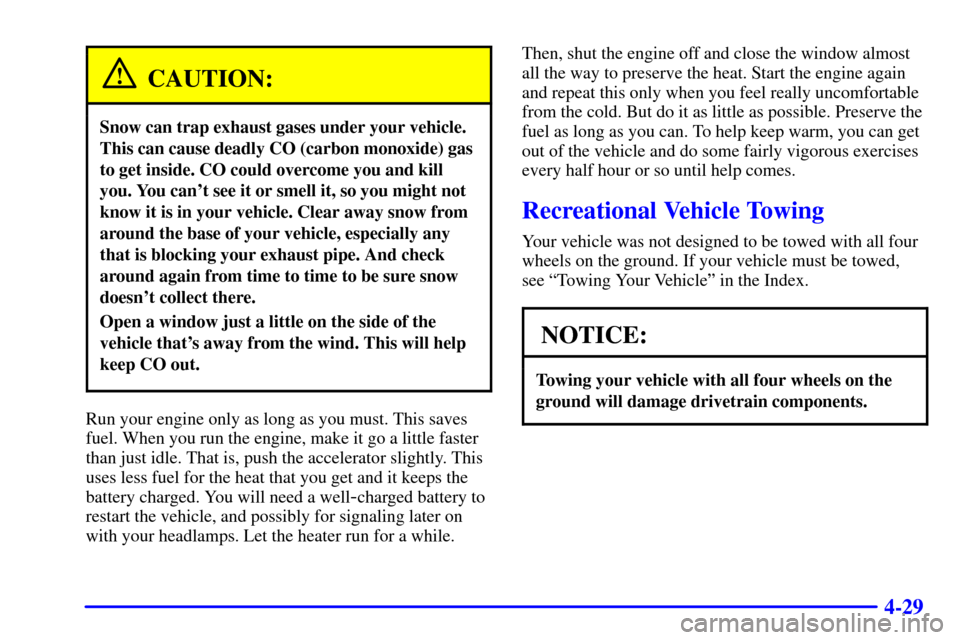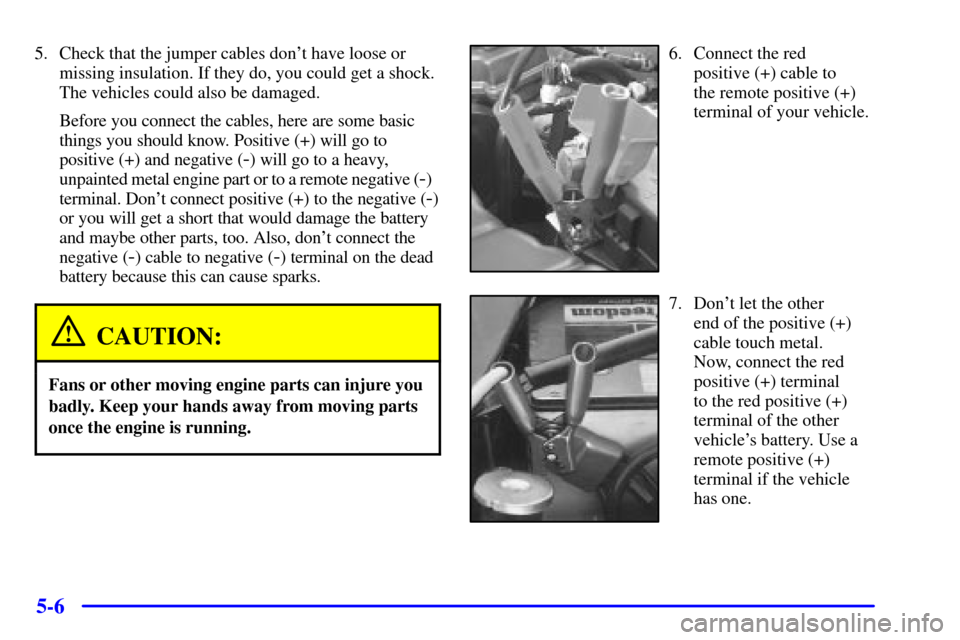Page 2 of 371
Every
2001 Seville
under warranty is
backed with the
following
services:
Free lockout assistance
Free dead-battery assistance
Free out-of-fuel assistance
Free flat-tire change
Emergency towing
1-800-882-1112
that provides in an emergency:
1-800-882-1112
Courtesy
Transportation
Page 243 of 371

4-29
CAUTION:
Snow can trap exhaust gases under your vehicle.
This can cause deadly CO (carbon monoxide) gas
to get inside. CO could overcome you and kill
you. You can't see it or smell it, so you might not
know it is in your vehicle. Clear away snow from
around the base of your vehicle, especially any
that is blocking your exhaust pipe. And check
around again from time to time to be sure snow
doesn't collect there.
Open a window just a little on the side of the
vehicle that's away from the wind. This will help
keep CO out.
Run your engine only as long as you must. This saves
fuel. When you run the engine, make it go a little faster
than just idle. That is, push the accelerator slightly. This
uses less fuel for the heat that you get and it keeps the
battery charged. You will need a well
-charged battery to
restart the vehicle, and possibly for signaling later on
with your headlamps. Let the heater run for a while.Then, shut the engine off and close the window almost
all the way to preserve the heat. Start the engine again
and repeat this only when you feel really uncomfortable
from the cold. But do it as little as possible. Preserve the
fuel as long as you can. To help keep warm, you can get
out of the vehicle and do some fairly vigorous exercises
every half hour or so until help comes.
Recreational Vehicle Towing
Your vehicle was not designed to be towed with all four
wheels on the ground. If your vehicle must be towed,
see ªTowing Your Vehicleº in the Index.
NOTICE:
Towing your vehicle with all four wheels on the
ground will damage drivetrain components.
Page 259 of 371

5-6
5. Check that the jumper cables don't have loose or
missing insulation. If they do, you could get a shock.
The vehicles could also be damaged.
Before you connect the cables, here are some basic
things you should know. Positive (+) will go to
positive (+) and negative (
-) will go to a heavy,
unpainted metal engine part or to a remote negative (
-)
terminal. Don't connect positive (+) to the negative (
-)
or you will get a short that would damage the battery
and maybe other parts, too. Also, don't connect the
negative (
-) cable to negative (-) terminal on the dead
battery because this can cause sparks.
CAUTION:
Fans or other moving engine parts can injure you
badly. Keep your hands away from moving parts
once the engine is running.
6. Connect the red
positive (+) cable to
the remote positive (+)
terminal of your vehicle.
7. Don't let the other
end of the positive (+)
cable touch metal.
Now, connect the red
positive (+) terminal
to the red positive (+)
terminal of the other
vehicle's battery. Use a
remote positive (+)
terminal if the vehicle
has one.
Page 260 of 371
5-7
8. Now connect the black
negative (
-) cable to
the good battery's
negative (
-) terminal.
Don't let the other end
of the negative (
-) cable
touch anything until the
next step. The other
end of the negative (
-)
cable doesn't go to the
dead battery.
Your vehicle has a
remote negative (
-)
terminal, marked
ªGND (
-)º located
near the power
steering fluid reservoir.
Attach the cable to
the remote negative
terminal provided.If the SECURITY light flashes, wait until the light
stops flashing before starting the engine.
9. Now start the vehicle with the good battery and
run the engine for a while.
10. Try to start the vehicle with the dead battery.
If it won't start after a few tries, it probably
needs service.
11. Remove the cables in reverse order (as shown in the
following procedure) to prevent electrical shorting.
Take care that they don't touch each other or any
other metal. Return the red positive (+) remote
terminal cover to its original position.
Page 261 of 371
5-8
Jumper Cable Removal Procedure
A. Remote Positive (+) Terminal
B. Good Battery
C. Heavy, Unpainted Metal Engine Part or Remote
Negative (
-) Terminal (GND)1. Disconnect the black negative (
-) cable from the
remote negative terminal (GND) or the heavy,
unpainted metal engine part on the vehicle that
had the dead battery.
2. Disconnect the black negative (
-) cable from
the negative (
-) terminal on the vehicle with the
good battery.
3. Disconnect the red positive (+) cable from the
vehicle with the good battery.
4. Disconnect the red positive (+) cable from the
other vehicle.